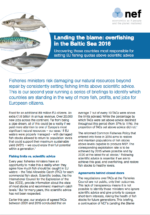Landing the Blame: Overfishing in the Baltic Sea 2016
Overfishing in the Baltic Sea 2016
20 November 2015
Fisheries ministers risk damaging our natural resources beyond repair by consistently setting fishing limits above scientific advice. This is our second year running a series of briefings to identify which countries are standing in the way of more fish, profits, and jobs for European citizens.
Food for an additional 89 million EU citizens. An extra €1.6 billion in annual revenue. Over 20,000 new jobs across the continent. Far from being a pipe dream, all of this could be a reality if we paid more attention to one of Europe’s most significant natural resources – our seas.
If EU waters were properly managed – with damaged fish stocks allowed to return to population levels that could support their maximum sustainable yield (MSY) – we could enjoy their full potential within a generation.
Fishing limits vs. scientific advice
Every year, fisheries ministers have an opportunity to make this a reality when they agree how much fish should be caught in EU waters – the Total Allowable Catch (TAC) for each commercial fish stock. Scientific bodies, like the International Council for the Exploration of the Sea (ICES), provide information about the state of most stocks and recommend maximum catch levels. But for many years, this scientific advice has not been respected.
Earlier this year, our analysis of agreed TACs between 2001 and 2015 concluded that on average 7 out of every 10 TACs were above the limits advised. While the percentage by which TACs were set above advice declined throughout this period (from 37% to 11%), the proportion of TACs set above advice did not.
The reformed Common Fisheries Policy that entered into force in 2014 aims to restore and maintain populations of fish stocks above levels capable to produce MSY. The corresponding exploitation rate is to be achieved by 2015 where possible and by 2020 at the latest for all stocks. Following scientific advice is essential if we are to achieve this goal, end overfishing, and restore fish stocks to healthy levels.
Agreements behind closed doors
The negotiations over TACs at the Fisheries Council are not public, only their outcomes. This lack of transparency means it is not possible to identify those ministers who ignore scientific advice and give priority to opaque short-term interests, risking the health of fish stocks for future generations. This briefing, a continuation of NEF’s Landing the Blame series6 will reveal which member states and ministers are behind decisions that go against the EU public’s collective interest.
It analyses the outcome of the negotiations and estimates which member states end up with a higher share of stocks fished above scientific advice. The working assumption is that these member states are the main drivers of overfishing either because they are actively pushing for fishing limits to be set above scientific advice or they are failing to prevent it.
This is the first updated briefing in our ‘Landing the blame’ series for 2016. You can view last years figures by clicking the links below.
Campaigns Landing the blame Fair, sustainable fishing
Topics Fisheries & farming







